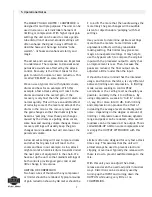
13
10. Calibration Procedure
n u
u
m
n u
u
m
Note: (1kHz sine at I/O: +4dBu/1.23Vrms)
Audio GR Vs Meter GR
tracking tolerance: +/- 0.1dB (from 0 to 2 dB of gain reduction).
Audio GR Vs Meter GR
tracking tolerance: +/- 0.5dB (from 3 to 7 dB of gain reduction).
(Matched PAIR of VU meters provides best tracking)
Note:
LINK Audio
GR tracking Left CH Vs Right CH Tolerance: (1kHz sine at I/O: +4dBu/1.23Vrms)
+/- 0.1dB @ 2dB of GR
+/- 0.3dB @ Up to 7dB of GR
(Matched QUAD of 6B6A's provides best link tracking)
Note:
LINK Meter
GR tracking Left CH Vs Right CH Tolerance: (1kHz sine at I/O: +4dBu/1.23Vrms)
+/- 0.1dB @ 2dB of GR
+/- 0.5dB @ Up to 7dB of GR
(Matched QUAD of 6B6A's and Matched VU meter provides best link tracking)
Things to remember about VU Meters:
Our VU meters being passive electro mechanical devices, no two meters are 100% identical (Electrical
specification: 1.228V = “0” VU +/- 10% tolerance), we test and match stereo VU meter assemblies to
obtain the best possible tracking.
loudness
PPM
The VU meter was not designed to measure signal, but to let users target a signal level of 0 VU
(sometimes labeled 100%), so it is not important that the device is non-linear and not precise at low
levels. The VU-meter (intentionally) "slows" measurement, averaging out peaks and troughs of short
duration, and reflects more of the perceived
of the material than the more modern and
initially more expensive
meters.
For this reason many audio practitioners prefer the VU meter to its alternatives, though the meter
indication does not reflect some of the key features of the signal, most notably its peak level, which in
many cases must not pass a defined limit. Since a VU meter is a mechanical device it can never reflect
the instantaneous signal peaks of complex audio signals. A VU meter does NOT measure peaks but
simply infer them. The engineer must know that with music or speech the Peak levels will always be
"inferred" to be between 6dB to 10dB higher than the reference level.




































